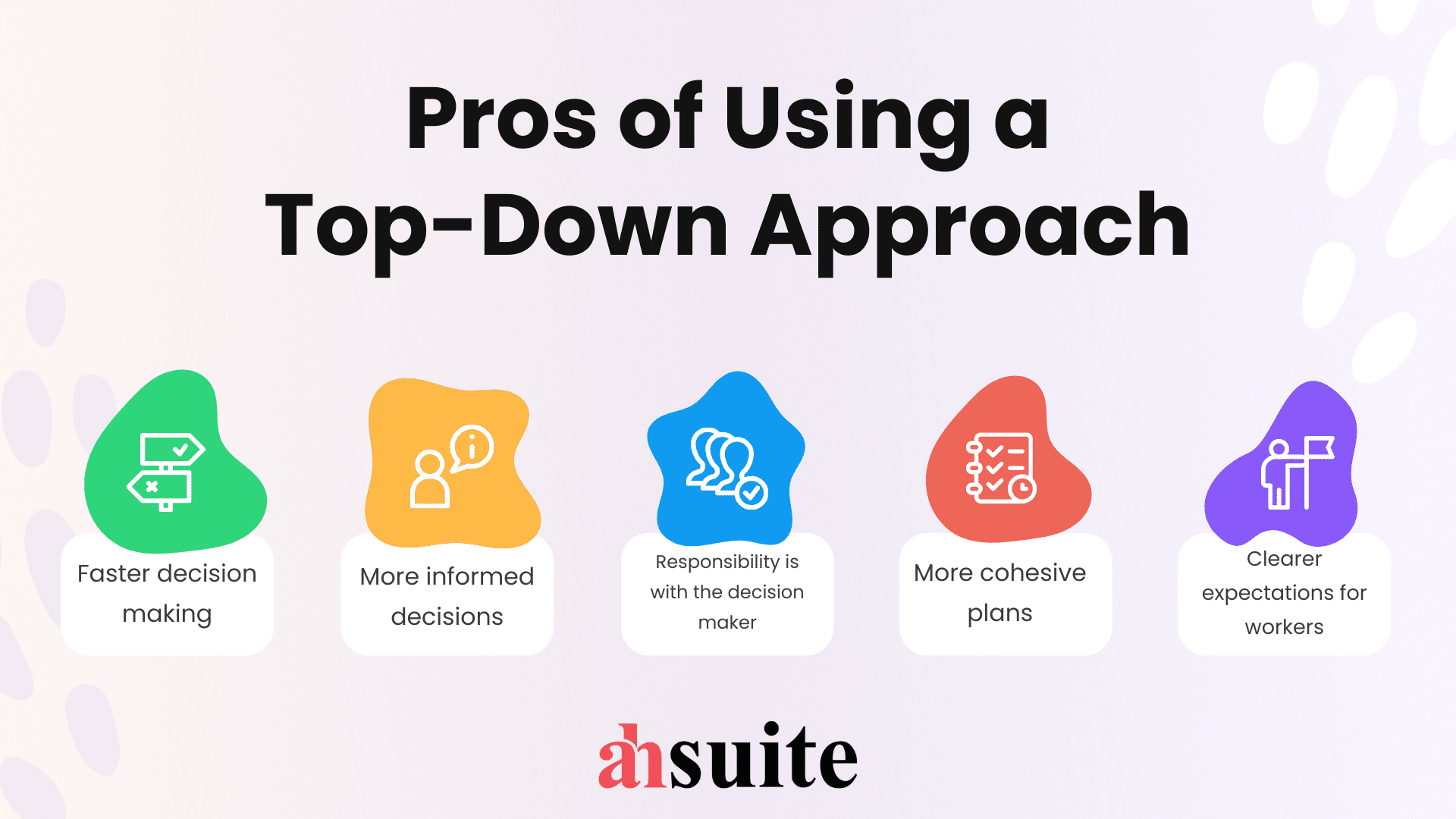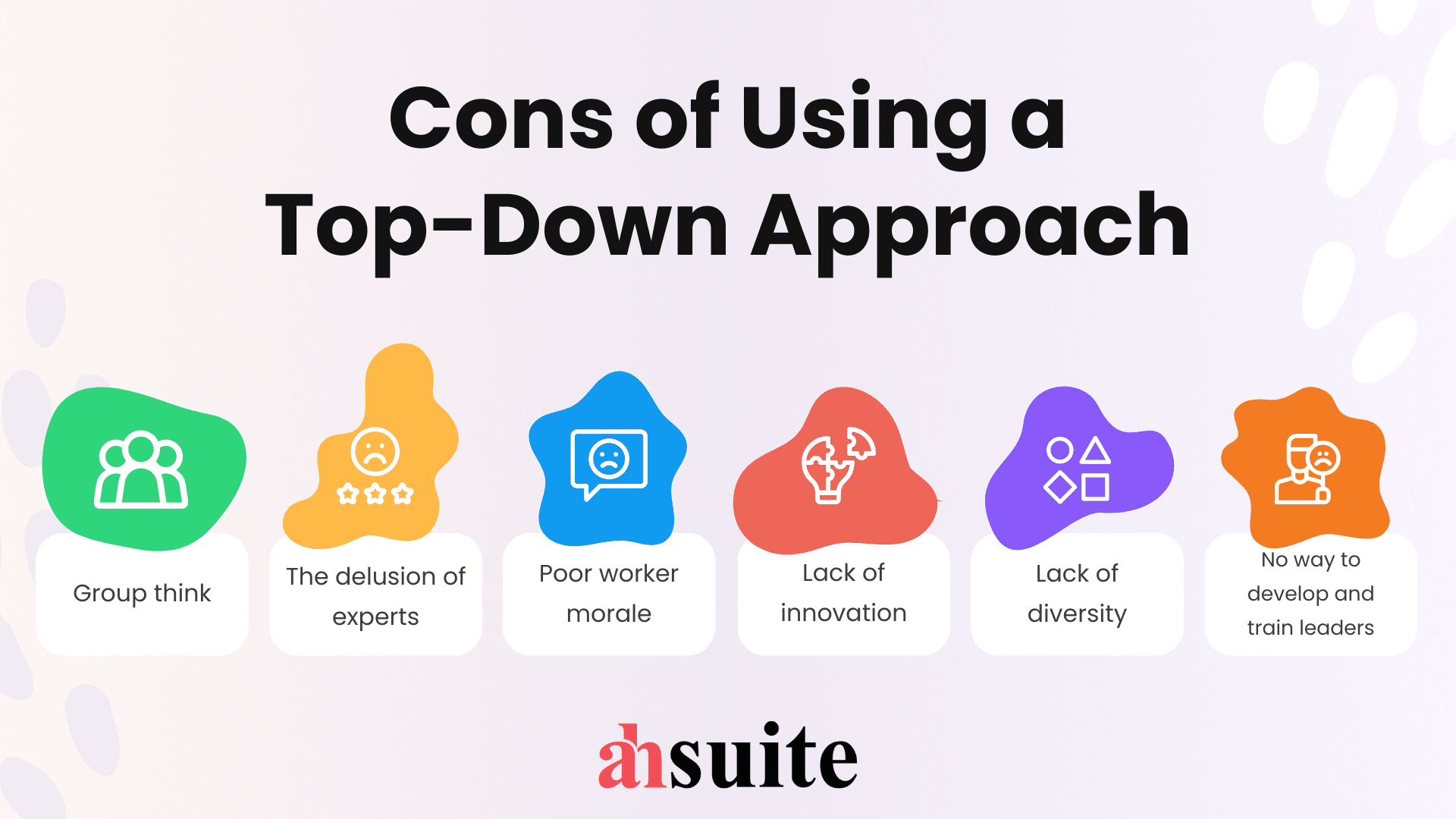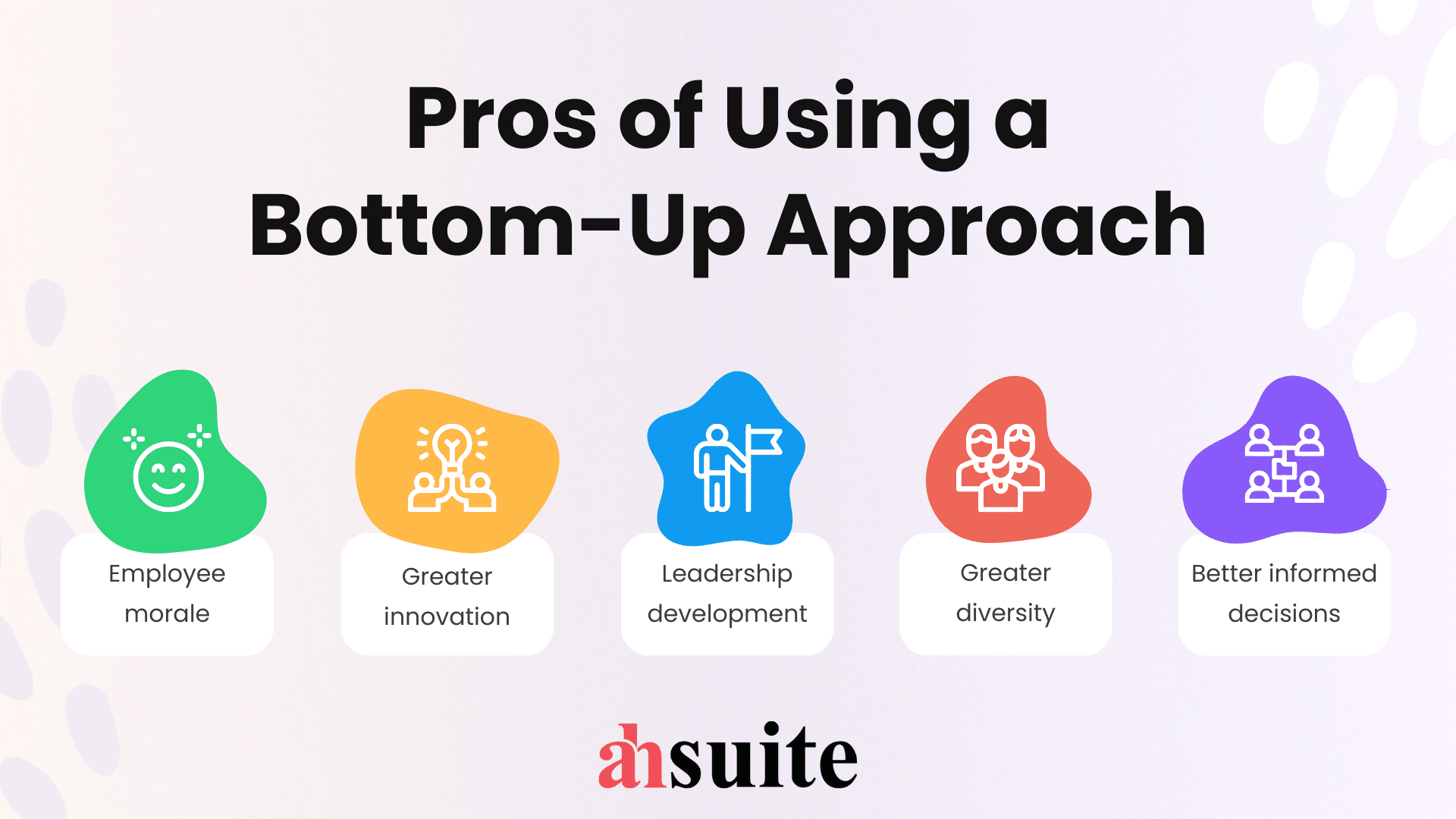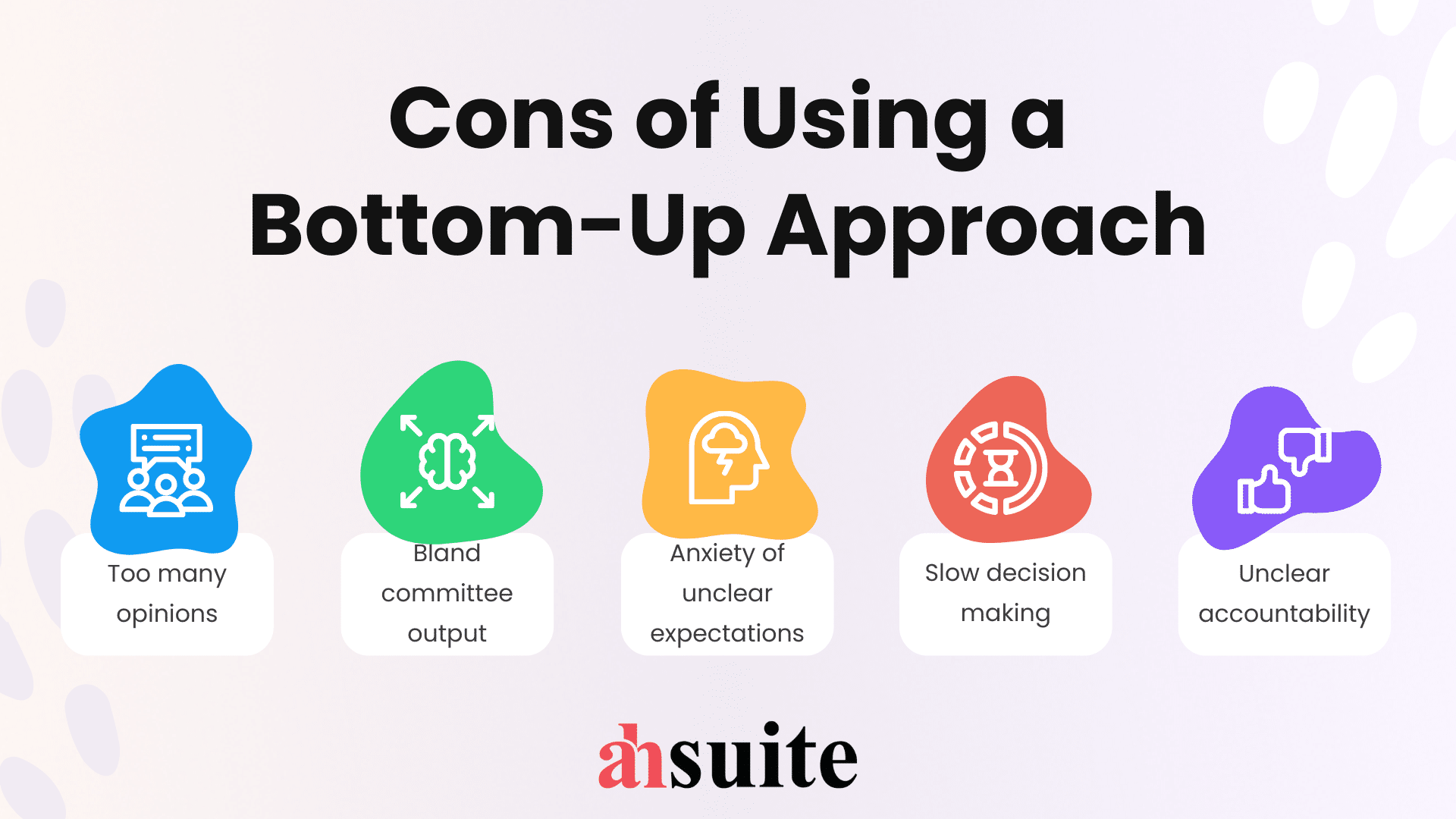As an employee, do you prefer explicit instructions from your manager, or would you rather have the freedom to find your own way to meet a target or objective?
Your answer may be a matter of personal taste or it might depend on the job being performed. Yet that choice reflects the basic dichotomy between top-down and bottom-up project management, and it impacts not only worker productivity and morale, but also the overall innovation and success of the business.
Now if you are like me, the idea of “top-down” management makes me think of evil totalitarian rule and “bottom-up” management makes me think of democracy and the will of the people. But in reality there are benefits and drawbacks to both approaches, and those connotations are not as useful when considering management styles for a firm.
In this article I will try to give a fair representation of both top-down and bottom-up project management styles, discuss their relative merits, and leave it to you to decide which style – or what mixture of the two – is best for your business.
What is a Top-Down Approach?
As the name implies, the top-down approach definition is a management style where decisions are made by upper management and handed down as directives to the lower levels of the business.
It is a hierarchical system that assumes the key information exists at the top of the hierarchy, where it can be disseminated down to the employees at the bottom.
How a Top-Down Approach Works
In a top-down management approach, it is the job of managers to gather and analyze information, make decisions, and articulate those decisions in a plan for the rest of the organization to execute.
For employees, this means receiving a clear process for the work that needs to be done. If you have ever been through training on a new job, you know what it is like to receive explicit directions from “the top” on how to do your job, even if it is something as simple as how to submit your timesheet.
However you wouldn’t say a business has a “top-down management approach” for telling you how to submit your hours to payroll. Typically a business with a top-down style of management will have executives and managers that make key decisions without involving all the employees in the decision making process.
Pros of Using a Top-Down Approach
Many of us have an ingrained sense that egalitarian systems are good, and hierarchical systems are bad. But that type of value judgment is not necessarily applicable to questions about organizational efficiency. Here are some of the reasons not to dismiss the top-down approach.

Faster decision making
One advantage of the top-down management approach is that when management doesn’t have to consult with everyone in the organization and gain their support, they can issue decisions and directives much faster.
If the decisions are bad, then faster decision-making is a bad thing. But if the decisions are good, then faster decision-making can be the competitive edge that an organization needs to win.
More informed decisions
The claim of top-down managers is that they have the information necessary to make the right decisions, and the reality is that sometimes they might be right.
Oftentime managers have access to data or research or other information that is not available to all the employees. After all the job of the manager is to see the big picture, and presumably they rose to their position because they proved to be effective decision makers.
Responsibility is with the decision maker
With a top-down approach, the people who make the decisions are the ones who will be blamed if things go wrong.
That can mean that because they will be held accountable, managers will be extra careful to ensure the decisions they make are wise and for the good of the company.
More cohesive plans
If you want an example of how top-down management can lead to a more cohesive vision, just thinking about the difference between an auteur film and a movie made by a committee of executives.
When decisions are made by a smaller number of people, their output will often be more cohesive and coherent than what could be achieved by a large group of people.
Clearer expectations for workers
Top-down management can be a relief for workers who just want to know what is expected of them so they can do their job. Not everybody wants the weight of every corporate decision weighing on their shoulders.
Cons of Using a Top-Down Approach
There are several disadvantages of using a top-down approach, including:

Group think
If all decisions are being made by an insular group of people, they can be subject to group think and myopia. Their job may be to see the big picture, but they may lack the diversity of perspectives to truly see it, and that may cause them to make decisions that are not in the best interest of the company.
The delusion of experts
Oftentimes people overestimate their own competence and underestimate the competence of their subordinates. The delusion of experts is that they know more than they do. That kind of thinking can be fatal to an organization that needs the input of all its employees.
Poor worker morale
People are not cogs in a machine, and they don’t like to be treated as such. Especially in the 21st century, businesses are finding that if they don’t give their workers a say in key decisions made by the company, those workers will often feel unmotivated and underutilized.
Lack of innovation
Organizations with a top-down approach often struggle to be innovative because they are not utilizing all the vast creativity and ingenuity possessed by their workforce.
Even if the CEO is the most creative person alive, they cannot know all the small details of every job performed within the company, or the unique needs or circumstances or preferences of the people doing those jobs. Yet so much of the innovation in a business can be in the small adjustments workers make to do their jobs more effectively.
Lack of diversity
When a business has a top-down management style, they risk missing out on the insights and perspectives of a diverse workforce that may reflect the diversity of their customers. For example, if all the managers are female, they may lack the male perspective that might help inform their decisions on products and services that apply to men as well as women.
No way to develop and train leaders
Lastly, the top-down management style does not cultivate the skills that workers need to grow into leaders and managers themselves. Nor does it provide an opportunity to recognize the skills that are already there, since workers are not given as much opportunity to demonstrate their excellence. In the long run, this can lead to an organization without qualified people to fill management roles.
When to Use a Top-Down Management?
A top-down management style is best when the upper management really does know best. On a micro level, imagine the relationship between a master and their apprentice. Does it really make sense for every decision to be a discussion? In some cases the best approach is for those with the expertise to give clear, direct instructions.
Top-down management also makes sense when operations have been refined and optimized. At that point, it can be more important for workers to follow a protocol than to negotiate their own way.
An example is a checklist in a hospital. We know that certain procedures should always be followed – such as washing your hands before surgery. When doctors are required to follow a checklist, errors are reduced. This is a kind of top-down management in action. Doctors are not invited to weigh in on whether they should wash their hands; they are instructed to do so.
Another example is when sales people are required to follow a sales script. Oftentimes a huge amount of research and trial and error has gone into producing the script, and requiring sales agents to follow it may make sense.
Related Article: How to Improve Project Time Management
What is a Bottom-Up Approach?
A bottom-up approach definition involves having workers participate in the decision-making process. Rather than issue dictates from on high, managers will solicit worker feedback and suggestions.
A bottom-up type of manager will generally give their workers more freedom and leeway to do things their own way. A key difference between top down and bottom up styles is that nstead of micro-managing, the manager will articulate goals and be flexible about how workers reach those goals.
How a Bottom-Up Approach Works
A company with a bottom-up management approach will create forums for employees to voice their opinions. They may welcome feedback, give credit for good suggestions, and allow time in meetings for group discussion.
They may also allow greater freedom in how employees do their work. They may evaluate worker productivity based on output, not based on how exactly they meet their goals.
Pros of Using a Bottom-Up Approach
There are many reasons that the bottom-up approach is in vogue among many large companies. Here are just a few of those reasons.

Employee morale
People like to feel heard, and that doesn’t change when they go to work for an employer. One advantage of the bottom-up management approach is that it is good for employee morale, since it encourages managers to involve their employees in decision making.
Greater innovation
A workforce is a huge reservoir of insight, knowledge, and creativity. When a business taps into that reservoir, it can have a steady flow of innovations both big and small. Oftentimes it is the accumulation of little innovations that make a bigger impact than the big innovations.
Leadership development
By involving your employees in making decisions, you teach them how to make those decisions for the company. You also get a chance to see who shows promise as a future leader within the organization. This process is essential for developing the leadership skills that will be necessary as workers rise in your organization.
Greater diversity
Unless your organization is staffed entirely by clones, a larger group of people is by definition more diverse than a subset of that group. Therefore to get a more diverse set of perspectives on key decisions in your organization, you can involve more of your employees in making those decisions.
Better informed decisions
When you incorporate information from more vantage points, you get a more complete picture. Insofar that everyone in your organization has a unique perspective to contribute to a particular decision, involving those perspectives will improve the quality of the decisions.
Cons of Using a Bottom-Up Approach
Bottom-up and top-down approaches both have their downsides. These are some of the downsides of the bottom-up approach to management.

Too many opinions
The downside of inviting everyone to weigh in on decisions is that you can end up with a huge number of opinions, many of which may be incompatible or contradictory. You may get bogged down trying to please everyone, and when someone voices an opinion they can often feel offended if their advice is not followed.
Bland committee output
There is a reason great works of art aren’t created by committees. Group input can have the effect of watering down any personality or perspective, leading to decisions that don’t please or offend anyone.
Anxiety of unclear expectations
Many people want to know exactly what to do and how success will be measured. For these people, a bottom-up approach can feel like a lack of direction.
Slow decision making
Soliciting, gathering, and analyzing input from all your employees takes time. Think of how much longer a meeting takes when everyone gets a chance to hold the floor. When speed is of the essence, the bottom-up approach can be too slow.
Unclear accountability
When an organization’s decisions are made collectively, who takes the blame for making the wrong decision? And if the blame is dispersed, which individuals feel the necessary pressure to get things right?
When to Use a Bottom-Up Management?
Bottom-up management is great for service-based organizations where a sensitivity to the human side of customer relations is key. It is one thing to make a widget factory run like a machine; it is another to try to run customer service like a machine. When your business delivers services, or any business that is customer-facing, bottom-up management creates a more human experience for all – including your customers.
It is also great for processes that require creativity, flexibility, and nuance. Presumably your business is staffed with people, not robots. Why not leverage their diverse talents and perspectives to improve your service or product?
Top-Down vs. a Bottom-Up: The Verdict
The top-down perspective entered this contest at a big disadvantage simply due to the negative connotations associated with hierarchical systems. Yet in many situations and contexts, it is a more efficient way to run a business and produces a more cohesive outcome.
At the same time, the bottom-up approach is much better at utilizing all that a workforce has to offer in terms of their ideas and creativity. For many employees, it is also simply the management style they prefer.
The reality is that every organization probably has some mixture of top-down and bottom-up management, and finding the right balance will be highly contingent on the specifics of your business.
Therefore the key takeaway is not that you should embrace top-down or bottom-up, but that you should be careful to consider the benefits of both approaches when finding the management style that is ideal for your business.

